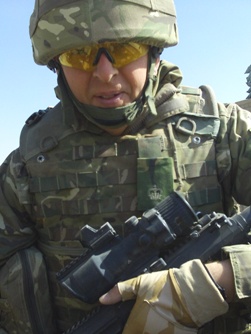
Steve Matthews is an engineering geologist working with the British Army in Helmand Province, Afghanistan, helping to repair the irrigation systems of the region.
Geoscientist 21.06 July 2011
As the heavily armoured British Army Mastiff truck rumbled to a halt, the machine gunner in the top turret swung his weapon through 180 degrees and called his arc of view clear. The engine noise died away to a low hum. The commander leant back into the crew compartment and gave us the thumbs up. I checked my SA80 A2 rifle, kicked the heavy doors open and stepped down into a spectacular Afghan dawn. Operation Tethys, the Royal Engineers’ contribution to the reconstruction of Helmand Province’s irrigation system, had begun.
The British Army has had established posts for a small number of geologists for nearly a century, the first operational British Army Geologist (William Bernard Robinson King) deploying to France to supervise well drilling during WW1. Since 1945, these geologists have been reservists drawn like me from the Territorial Army, who practise geology professionally as civilians but maintain basic military skills through an annual part-time training programme. Although the Ministry of Defence uses civilian consultants in the same way as any other government department, there are occasions where, for security or operational reasons, Royal Engineers Geologists are called upon to provide specialist expertise. Operation Tethys was such a project.
Operation Tethys was conceived by the Royal Engineers 170 (Infrastructure Support) Group as a means of assisting the reconstruction of the Helmand Valley irrigation system in late 2010. A number of critical project sites had been identified, where failing earthworks and mechanical systems were threatening operational integrity. The Provincial Reconstruction Team (PRT), based in Lashkar Gah, had sourced international for the project, which clearly needed to liaise with the Helmand and Arghandab Valley Authority (HAVA - the Afghan organisation responsible for managing the canal system) in order to convert initial outline concepts into deliverable projects. Many of these were located in areas where civilian staff movement was difficult because of the security situation.
Operation Tethys, therefore, consisted of a six-man team drawn from both regular and reserve Royal Engineers. The team contained men with expertise in relevant disciplines (two civil engineers, a mechanical engineer, a coastal defence specialist, and an engineering geologist) as well as the military capability to slot seamlessly into the existing security patrol profile, fighting if and when required. Its mission was, in summary, to conduct site reconnaissance at the critical project sites and design achievable solutions in partnership with HAVA.